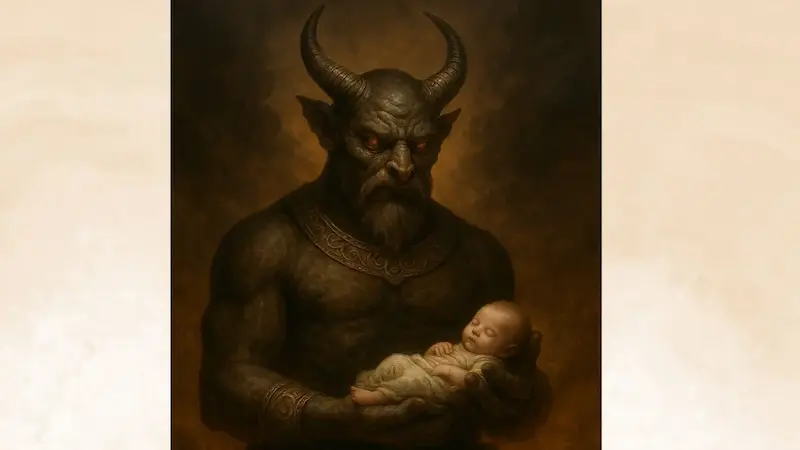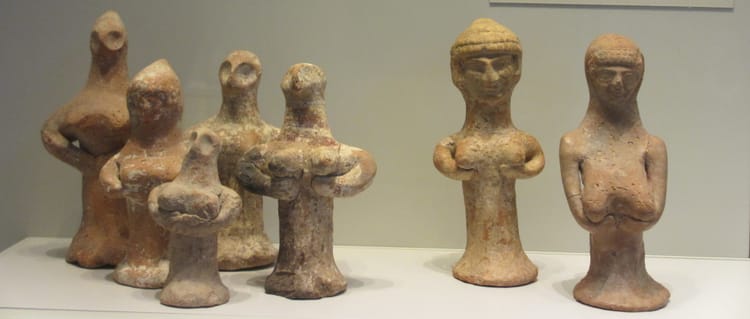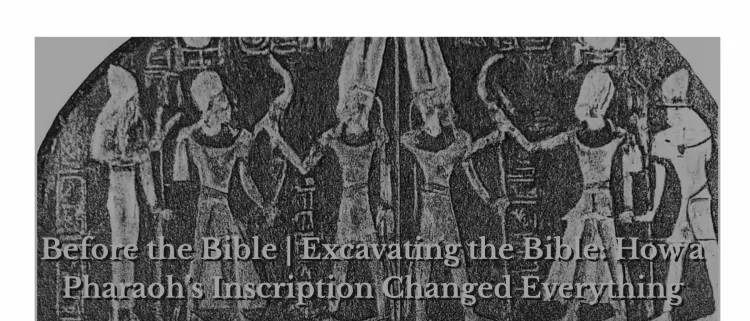Human Sacrifice in Ancient Israel: The Specter of Moloch

Table of contents
When you think of child sacrifice, your mind likely jumps to ancient Canaanites or grim Phoenician rituals, and certainly not to the Israelites—the supposed poster children for divine commandments and moral codes. And yet, the texts that form the moral spine of Western religion can’t stop bringing it up. Not to praise it, mind you, but to condemn it with a degree of fervor that raises eyebrows. Because when someone screams about something that often, you start to wonder: who exactly are they trying to convince?
Moloch: God, Ritual, or Convenient Villain?
Enter Moloch. Depending on which scholar you ask, he was either a horrifying deity, a ritual practice, or a very effective piece of religious propaganda. The Bible paints him as a monstrous being who demands children be burned alive—because what better way to showcase the superiority of your own god than by inventing a bogeyman with an appetite for toddlers?
Biblical authors mention Moloch with a kind of dramatic flair:
“You shall not give any of your offspring to sacrifice them to Molech...” (Leviticus 18:21, NRSVUE)
“Solomon built a high place... for Molech the abomination of the Ammonites...” (1 Kings 11:7, NRSVUE)
“They built the high places of Baal... to offer up their sons and daughters to Molech...” (Jeremiah 32:35, NRSVUE)
The tone isn’t subtle, and that’s the point. This was a theological performance: one designed to draw thick, flaming lines between the Israelites and their neighbors—and maybe, just maybe, between Israelites and their own embarrassing past.
Was Moloch Even a God?
Probably not, at least not in the traditional sense. Modern scholars have suggested that Molech may not have been a deity at all, but a type of sacrificial offering—an unfortunate euphemism for tossing your child into a fire. In Punic inscriptions, mlk refers to a class of offerings made to deities like Baal Hammon or Tanit, never to a god named Moloch.
“The biblical writers have deliberately vocalized mlk as Molek with the vowels of boshet, ‘shame’, to denote the abominable character of the worship.” (Day 14)
To drive the point home, the word Molech might be a Hebrew mash-up: melech (“king”) plus the vowels of boshet (“shame”). That’s not a name—it’s a roast.
Religious Cross-Pollination (a.k.a. Syncretism)
So how did this ritual end up in Israelite society? Blame the neighbors. The Phoenicians and Canaanites, known for their festive pantheons and questionable rituals, had a habit of rubbing off on nearby cultures. The Israelites, despite their prophets’ best efforts, were not immune.
Child sacrifice likely came into Israelite practice via religious syncretization—the spiritual equivalent of mixing oil and water and pretending it tastes better that way. It wasn't a central tenet of Yahwism, but it made enough of an appearance for the prophets to lose their collective minds over it.
And while there’s no archaeological smoking gun from Jerusalem, there is one from Carthage, a Phoenician colony. Excavations at the Tophet of Carthage uncovered urns filled with the cremated remains of infants and young animals—likely the remnants of sacrificial rituals performed to secure divine favor. Scholars debate whether every burial was a sacrifice, but the evidence strongly supports the presence of ritualized child offerings.

This discovery in Carthage helps shed light on the biblical references to Topheth, the sacrificial site mentioned in the Hebrew Bible:
“And he defiled Topheth, which is in the Valley of the son of Hinnom, so that no one would make a son or daughter pass through fire as an offering to Molech.” (2 Kings 23:10, NRSVUE)
“And they go on building the high place of Topheth... to burn their sons and their daughters in the fire.” (Jeremiah 7:31, NRSVUE)
“For Topheth has long been ready; truly it is prepared for the king, its fire made deep and wide.” (Isaiah 30:33, NRSVUE)
The biblical Topheth, associated with the Valley of Hinnom, seems to be Israel’s version of a sacrificial site much like the Tophet of Carthage—demonstrating shared cultural patterns among Semitic peoples of the ancient Near East.
Yes, They Really Did This
It’s not just inferred. The Hebrew Bible admits—grudgingly and repeatedly—that some Israelites offered up their children. Not metaphors. Real kids. To real fires.
“They built the high places of Baal in the Valley of the son of Hinnom, to offer up their sons and daughters to Molech...” (Jeremiah 32:35, NRSVUE)
Also:
2 Kings 16:3: King Ahaz, notably not voted Parent of the Year.
Ezekiel 23:37: More accusations, less subtlety.
And then there’s Jephthah, the Old Testament’s cautionary tale about making vows when you’re emotional. After a military win, he promises to sacrifice the first thing that greets him at home. Spoiler: it’s his daughter.
“...he did to her according to the vow he had made.” (Judges 11:39, NRSVUE)
No divine intervention. No condemnation. Just an eerie silence that suggests this sort of thing wasn't unheard of.
Josiah: The Cleanup Crew Arrives
Fast-forward to King Josiah, the religious reformer who bulldozed altars and outlawed sacrifices like a monarch on a mission:
“And he defiled Topheth... so that no one would make a son or daughter pass through fire as an offering to Molech.” (2 Kings 23:10, NRSVUE)
Many scholars see this not as a new law, but a late-in-the-game cover-up—a post hoc declaration that the kingdom had always been morally opposed to child sacrifice, even if it hadn’t acted like it.
Because here’s the uncomfortable truth: the fiercer the denunciation, the likelier it was a real problem. People don’t issue screaming bans on things no one is doing.
Gehenna: From Sacrifice Site to Hellfire Metaphor
Now we come to the Valley of Hinnom, a real place with a reputation that only worsened over time. Originally the site of child sacrifice rituals, it later became symbolic shorthand for divine judgment. Enter: Gehenna.
By the New Testament era, Gehenna had evolved into a stand-in for Hell:
“...fear him who can destroy both soul and body in Gehenna.” (Matthew 10:28, NRSVUE)
Because nothing says moral clarity like turning the old neighborhood death pit into a metaphor for eternal torment. It’s poetic justice—if you overlook the flaming corpses.
“Gehenna… came to symbolize the place of eschatological punishment.” (Collins 87)
Final Thoughts from the Ashes
Child sacrifice was not some pagan slander invented by Israel’s enemies—it was a skeleton in the national closet. The Bible itself admits it happened. It was likely adopted from surrounding cultures during periods of religious drift, practiced by people in power, and only later condemned as heresy when reformers like Josiah began sanitizing the national narrative.
Moloch—whether a god, a ritual, or a symbolic scapegoat—became the face of that past. And Gehenna, the infernal landfill of all those regrets, became the place where bad theology and worse behavior went to burn forever.
FAQ
Is “Molech” a literal deity or a sacrificial term?
Many scholars read mlk as a class of offerings attested in Punic inscriptions; later writers likely personified it for polemical clarity.
Did Israelites actually practice child sacrifice?
Biblical texts acknowledge it (e.g., 2 Kings 16:3; Ezek 23:37; Jer 32:35; Judges 11), and reforms under Josiah target the practice explicitly.
What is the link between Topheth and Gehenna?
Topheth (Valley of Hinnom) is the Jerusalem locus associated with child offerings; over time its memory informed “Gehenna,” a metaphor for judgment.
Is there archaeological proof?
Carthage’s Tophet contains urns with cremated infants and animals consistent with votive offerings; while debated, evidence supports ritualized child sacrifice.
Works Cited
- Collins, John J. The Apocalyptic Imagination: An Introduction to Jewish Apocalyptic Literature. 3rd ed., Eerdmans, 2016.
- Day, John. Molech: A God of Human Sacrifice in the Old Testament. Cambridge University Press, 1989.
- Ehrman, Bart D. God's Problem: How the Bible Fails to Answer Our Most Important Question—Why We Suffer. HarperOne, 2008.
- Smith, Mark S. The Early History of God: Yahweh and the Other Deities in Ancient Israel. 2nd ed., Eerdmans, 2002.
- Stager, Lawrence E., and Samuel R. Wolff. “Child Sacrifice at Carthage—Religious Rite or Population Control?” Biblical Archaeology Review, vol. 10, no. 1, 1984, pp. 31–51.
- The Holy Bible, New Revised Standard Version Updated Edition. National Council of Churches, 2021.





Comments ()